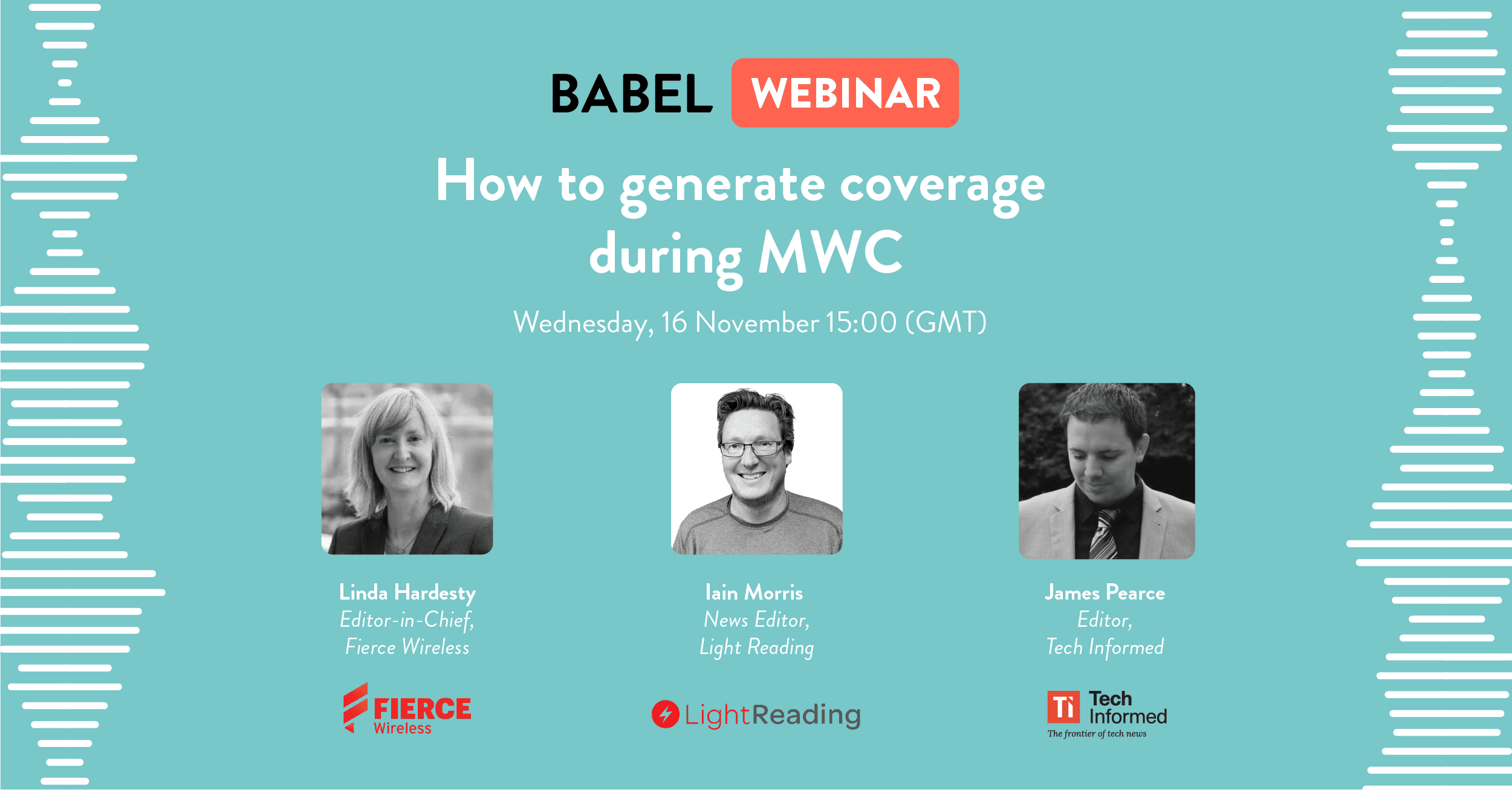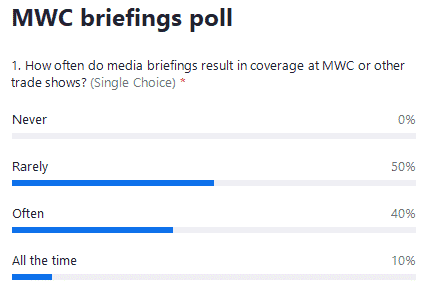
Generating coverage at Mobile World Congress – webinar debrief
Now that the dust has settled on Babel’s most recent webinar: ‘How to generate coverage at MWC’, it feels like a good time to revisit the session and discuss what we learned.
We were lucky enough to be joined by three fantastic journalists, Linda Hardesty, Editor-in-chief at Fierce Wireless, Iain Morris, News Editor at Light Reading, and James Pearce, Editor at Tech Informed. They were joined by our resident Telecoms expert, Babel Director Paul Campbell.
For a debrief on the session, and to learn just how to generate coverage at the world’s largest telecoms event, read on…
(Of course, you don’t have to take my word for it – you can listen to the session in full here.)
When is the best time to release news around MWC?
The aim of the game (or at least, one of them) at MWC is to try and generate coverage for your business. Because of this, most brands will announce big news around or during the event to drum up interest and give journalists a reason to come to talk to their spokespeople.
Sounds great right? However, since everyone does the same thing, you risk your announcement (and potential coverage) being lost in the noise. Journalists are busy at the best of times, but for MWC they are inundated with mountains of news at once, alongside having to, well, actually attend Mobile World Congress. This means journalists like Linda, Iain and James only have so much time and attention to give leading up to, and during, the show. So, timing can be everything. We asked our audience when they typically put out their news for MWC which you can see below, but what did our experts think?

Despite almost half of the respondents often releasing news the week of MWC, our panellists did not advise this. “Definitely not the week of MWC!” says Iain Morris, explaining that checking emails during the show is almost impossible, and things can easily go unnoticed. The other panellists agreed, saying a few weeks before is the preference.
Interestingly, Linda and James both talked about the value of the time directly after MWC (or any big industry event) that PRs, particularly for smaller brands, often don’t make good use of. They described the lack of news & content in the aftermath of the event – a figurative hangover from the week-long event almost. Linda advised smaller brands to leverage this downtime and target this period to release news or pitch stories.
However, all agreed that it’s not just about timing, some of the finer points of media relations go a long way in the leadup to MWC (and year-round). Iain and Linda both talked about how they are more likely to engage with news from companies or PRs who they know and recognise. They also talked about one of their shared pet peeves: being sent stories or releases “under embargo” without having agreed to the embargo to begin with!
Iain adds a point about the importance of building up your media relationships beforehand. "It's not just a Feb/March thing. You notice the emails/calls from the names you're familiar with."
— Babel PR (@BabelPR) November 16, 2022
Getting the most out of media briefings at MWC
Journalists having easy access to your brand’s key spokespeople is one of the main draws of any large industry event. Securing briefings with good journalists then is arguably the core mission from a PR perspective – it’s one of the main reasons companies put out news specifically for the event. But how successful are briefings at MWC, and what are the tricks to getting the best out of them? We asked our panel, and our audience (below).

Our panel was surprised by this result. ‘I don’t like wasting my time’ said Linda. When she does take the time to meet someone, she’ll almost always write about it. Iain feels similar but noted that these days he takes fewer briefings than ever, often going to an event with a few key people in mind with whom he wants to speak to. James noted that while he doesn’t like doing it, he has on occasion not published anything off the back of less interesting briefings.
So how do you increase your chances? All the panellists talked about making it interesting and different where possible. What is classified as interesting will differ between people, but it’s crucial spokespeople focus on what is interesting to journalists – this is often the first hurdle people fall on. Iain advised focusing on the ‘interesting big trends you know we write about.’ The panellists also noted that pre-prepared slide presentations and ‘salesy’ speech miss the mark, just like at the other end of the spectrum with overly technical presentations – ‘there’s a mismatch there’, says Iain.
The journalists also advised not to undervalue the impact of the more ‘out-there’ or ’fun’ things that can make a brand stand out – robots were given as examples several times, from robot dogs to robot bartenders – and they don’t even have to work particularly well! James talked about the latter being a hit at MWC 2022, despite it being “one of the worst pints I’ve ever had”, it gets people’s attention and draws crowds – journalists included!
@jpearcejourno "One of the biggest crowds at #MWC22 was the robot bartender. It's the worst bartender I've ever had, but it was funny, got attention, and got people there to the stand."
— Babel PR (@BabelPR) November 16, 2022
What topics are journalists interested in?
So, a key part of making briefings interesting is understanding what topics journalists want to hear about – but what are they? We asked our panellists, and the topics that came up are:
- Private Wireless
- Fixed Wireless Access (FWA)
- Satellite connectivity/NTNs
- 5G
- Private networks
- Open RAN
- Cloud & the role of hyperscalers
- 6G
@TechInformed is looking at use cases in telecoms. #IoT in factories, private 5G. "What I found good at #MWC22 was that I started to see why 5G matters now." says @jpearcejourno. "If you come to me with a really good case study, then great, I love it, show me all the pictures!"
— Babel PR (@BabelPR) November 16, 2022
How should you approach journalists?
Finally, we opened the questions up to our audience and they wanted to know what the best method of reaching journalists is. This is a never-ending question these days in PR, and the panellists’ answers matched what we believe here at Babel – it depends. Iain is a big believer in the classic phone call – ‘the best companies or PRs give you a call’, while Linda prefers not to be contacted on the phone. James couldn’t have summed it up better:
@jpearcejourno "It's about having the relationship and knowing who you're pitching to. If you know they're an email/phone/social person then you'll know how to approach them."
— Babel PR (@BabelPR) November 16, 2022
This last point shows the value of a good PR agency. A team with experience in the sector will know key journalists and have strong relationships with them, they’ll know how they like to be contacted, and what topics they like to cover. If you’re in Telecoms (or even just Tech in general) and need a PR agency that gets it – get in touch with Babel.
Well, that’s a wrap on our MWC webinar, don’t forget you can catch the full recording here. For more information and updates leading up to MWC, make sure to follow us on socials and we’ll see you there!
Written by Joel Goodson
Senior Content Writer





